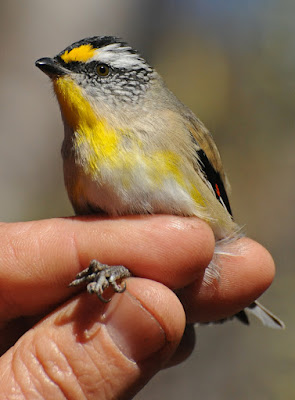I was out checking tawny frogmouths today, and was glad to see this female's partner on a new nest. But she had a surprise for me - she is colour-banded. I hadn't approached her too closely on previous visits and she hadn't shown her legs, nor have I had any reason to look at them as I have not marked any of my study birds to date. She has one pink plastic band on each leg and no metal ring from the banding scheme, so I suspect that she has escaped from captivity of some form. The bands look like pigeon racing or bird-fancier type; plastic with a clip closure. They also seem to have once been red, but now faded to pink under the UV light. If anyone out there knows anything about her origin, where and when she was banded, it would be very interesting to me. How far has she traveled and how old is she?
I am glad to see her free and breeding whatever her story. She is quite a well-marked bird with lots of rusty flecking in her plumage, and she has a thick dark necklace pattern.Well done if she did escape.
Yeh!! Free!!











